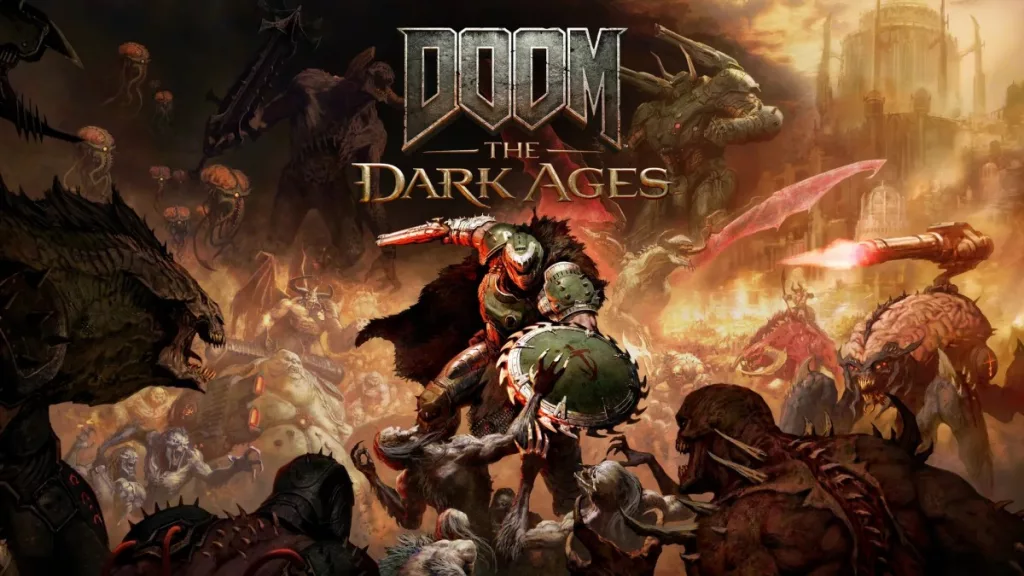
DOOM: The Dark Ages arrives next week, and it’s looking like most folks will be able to experience high frame rates using its Ultra Nightmare preset when gaming at 1080p or 1440p. Using the id Tech 8 engine, the latest entry features ray traced global illumination and, as is normal, is primarily a GPU-bound title, but that’s not a bad thing. While the current DOOM series has been GPU-bound, id Tech has done well in making them very scalable across a wide range of GPU models and resolutions, and this latest game is no exception. There are six graphics setting presets: Low, Medium, High, Ultra, Nightmare, and Ultra Nightmare. Multiple reviews (1, 2, 3) have given a general idea of what will be needed to game at 1080p, 1440p, and 4K.
DOOM: The Dark Ages acts as a prequel for DOOM Eternal (2020) and DOOM (2016), giving players a chance to see the roots of the Slayer’s epic story with, per Bethesda, “over-the-top” visuals. Its release coincides with the latest GPU generational launches from AMD, Intel, and NVIDIA and will support FSR 3.0, Xess, and DLSS 4 (including Multi-Frame Gen 3x/4x) on launch day. However, it should come as a relief to many to know that no upscaling technology is needed to play the game at its highest settings with many mid-tier cards at either 1080p or 1440p. However, those seeking to see all of the game’s carnage at 4K will need a top-tier card to do so or resort to upscaling to reach above 60 FPS.
1080p breakdown using Ultra Nightmare preset
PC owners still holding onto their 1080p displays have little to worry about when using the highest preset level without using upscaling. Reviews have shown that players can achieve 60 FPS with graphics cards such as an AMD RX 6800 16 GB or NVIDIA RTX 3070 8 GB but also be in the general vicinity with an Intel Arc B580 12 GB, NVIDIA RTX 3060 Ti, or AMD RX 6750 XT if they don’t mind dips into the low 50s/high 40s. However, if wanting to reach upwards of 120 FPS, something like an overclocked RTX 3090 Ti 24 GB/RX 7900 XT 20 GB will at least be needed.
1440p breakdown using Ultra Nightmare preset
As expected, things get a bit tougher on hardware, but it’s still not the end of the road for those with older graphics cards or newer, more budget-friendly options. At 1440p, players are going to need at least an RTX 3080 10 GB or RX 7900 GRE 16 GB to nail that 60 FPS target, but an overclocked RX 7800 XT 16 GB should also be able to come in close or above. Unfortunately for those not wanting to use upscaling, either an RTX 4090 24 GB or RTX 5090 32 GB will be needed if wanting to get to 120 FPS.
4K breakdown using Ultra Nightmare preset
Well, at 4K, using the Ultra Nightmare preset is pretty much a nightmare for most users, if not using upscaling. NVIDIA’s top-tier cards are more or less required if wanting to reach 60 FPS. The RTX 4080 SUPER 16 GB, when overclocked, could reach upwards of 60 FPS, as could an RTX 5080 16 GB, but otherwise players will need either an RTX 4090 or RTX 5090.
Quality Upscaling settings using Ultra Nightmare preset
Once again, upscaling technology will be the emergency parachute for many wanting higher framerates, if they don’t mind a bit more lag. At the forefront of this approach is NVIDIA’s DLSS 4, featuring x3 and x4 multiframe generation. It’s been said that DOOM: The Dark Ages performs well using x4, but given the fast-paced nature of the franchise, most would still do better to stick with either x2 or x3 to keep latency to a minimum. That being said, NVIDIA’s RTX 50 series shines here, and using MFG x3 combined with DLAA, even an RTX 5060 Ti 8 GB can attain a staggering 171 FPS at 1080p, albeit latency is unfortunately 36 ms, which is sure to be noticeable. Similarly, a 5070 Ti at 1440p, MFG x3 using DLAA, reaches 184 FPS with 37 ms of latency. Meanwhile, the RTX 5090 continues this scaling trend at 4K, MFG x3, and DLAA, at 189 FPS and latency at 35 ms.
An NVIDIA RTX 50-series graphics card is by no means required for an optimal playing experience using upscaling technology. At 1080p, anything from an RX 6600 XT 8 GB, RTX 3060 12 GB, or Arc A770 16 GB can hit around or above 60 FPS. Players with an RX 7800 XT/RTX 3080 can get within sight of 120 FPS, and even the Arc B580 is seen reaching over 83 FPS.
Taking this up a notch to 1440p and the RTX 3060 Ti 8 GB, Arc B580, and RX 6800 all hit similar marks around or higher than 60 FPS. To get in the area of 120 FPS, folks will need at least an RTX 4070 Ti/RX 9070. At 4K, things are still tough, but 60 FPS is nearly attainable with an RX 7900 GRE/RTX 3080/RTX 4070, but easily doable with anything more powerful than an RTX 4070, which, when overclocked, can probably get over 60 FPS at 4K.
